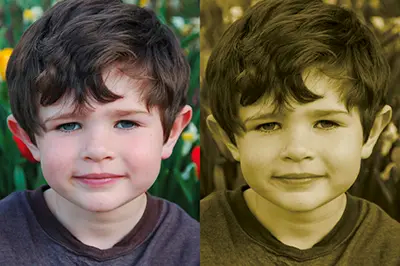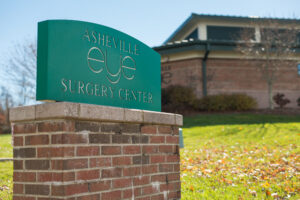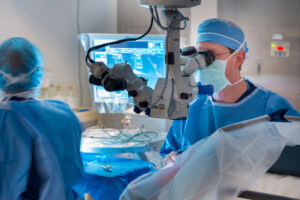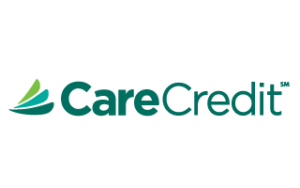Cataracts
Cataracts affect more than 24.4 million Americans age 40 and older and by age 75, approximately half of all Americans have cataracts. Once upon a time, cataracts surgery was considered risky, requiring a legthy hospital stay. Today, however, cataract surgery is one of the most common and sucessful medical procedures performed.
At Asheville Eye Associates, our team of experienced providers screen for and treat cataracts using the latest in cataract technology.
What Causes Cataracts?
Symptoms of Cataracts:
- Colors appearing less bright and vivid
- Sensitivity to glare from lamps, the sun, or headlights
- Difficulties seeing at night
- Problems reading, watching television, or seeing facial expressions
- Halos around lights
- Frequent need for a stronger eyeglass prescription
- Distortion or ghost images

Cataracts can make images appear dull or yellow

Blurry or dim vision is a symptom of cataracts

Cataracts can cause distortion or ghost images
Treating Cataract Through Traditional Surgery
Traditional cataract surgery is a manual, handheld-blade version of cataract surgery. The process starts with the surgeon making a small incision in your cornea. Through this opening, a small instrument is inserted. It is placed behind your pupil, where the natural lens sits in a capsule. In the capsule, a round opening is created by the surgeon. Then a pen-shaped probe is inserted through that opening. This allows the probe to break up the cloudy lens by applying ultrasound energy. The surgeon will then proceed to suction out the broken-up pieces. Your lens will be replaced with an artificial intraocular lens (IOL). Lastly, the surgeon will self-seal to close the incision typically without stitches.
The Latest in Cataract Technology
Asheville Eye offers the RxSight™ Light Adjustable Lens, the first and only intraocular lens (IOL) that can be customized after cataract surgery. The Light Adjustable Lens is made of a special photosensitive material that can be adjusted in response to ultraviolet (UV) light. This optimization is done by your eye doctor in the weeks following lens implantation through a series of non-invasive light treatments that take only a few minutes each. You will have the unique ability to adjust and preview your vision until it meets your personal desires and lifestyle requirements.
Laser Assisted Cataract Surgery with ALLY
Laser Cataract surgery with the ALLY femtosecond laser allows Asheville Eye surgeons to deliver a personalized and precise cataract procedure to our patients:
- Customization: Your eye is unique. The ALLY Laser allows our surgeons to personalize your cataract treatment based on the type and density of your cataract and the amount of astigmatism you may have.
- Safety: ALLY’s imaging helps our surgeons remove your cataract safely. Additionally, the laser softens the cataract before it is removed, adding to the overall safety of the procedure.
- Precision: Your surgeon uses next- generation laser technology allowing for optimized treatment in the lens to soften your cataract and on the cornea to create your micro-incisions.
- Results: The ALLY Laser is an important part of achieving the vision you want after cataract surgery. It helps guide your surgeon so they can deliver your best possible vision.
- Improved Experience: The next-generation ALLY Laser is faster than other lasers used in cataract surgery helping to improve your experience and potentially shortening your procedure time.
Watch our patient education video HERE
Cataract Surgery at Asheville Eye Associates
You will arrive at the surgery center about an hour prior to your procedure. Once you have been checked in you may be offered a sedative to help you relax. You will then be prepared for surgery. The area around your eyes will be cleaned and a sterile drape may be applied around your eye.
Eye drops or a local anesthetic will be used to numb your eyes. When your eye is completely numb, an eyelid holder will be placed between your eyelids to keep you from blinking during the procedure.
Once the procedure is completed, you will go home soon after and relax for the rest of the day. Everyone heals somewhat differently, but many patients report improvement in their vision almost immediately after the procedure. Most patients return to their normal activities within a day or two.


Find out more about Care Credit HERE.
What will my vision be like after cataract surgery?
Your vision after cataract surgery depends on the unique characteristics of your eye, the type of technology used during surgery (laser or traditional), and the intraocular lens (IOL) that is implanted. Your Asheville Eye surgeon will do a thorough assessment of your lifestyle and visual needs to recommend a personalized surgical plan.
Secondary Cataracts
People who have had cataract surgery may have their vision become hazy again years later. This is usually because the lens capsule has become cloudy. The capsule is the part of your eye that holds the IOL in place. Your ophthalmologist can use a laser to open the cloudy capsule and restore clear vision. This is called a capsulotomy.
Ready for an evaluation?
Make an appointment with one of our cataract surgeons:
- James D. Crandall, M.D. (Asheville & Hendersonville Offices)
- William L. Haynes, M.D. (Asheville Office)
- Damien C. Macaluso, M.D. (Asheville Office)
- Jordan S. Masters, M.D. (Asheville Office)
- Michael Oswald M.D. (Sylva & Franklin Offices)
- Alexander R. Walters, M.D. (Asheville Office)
- Daniel Yoder, MD (Hendersonville Office)


